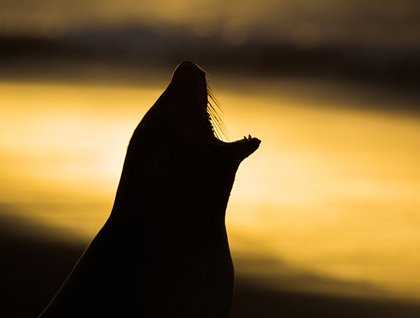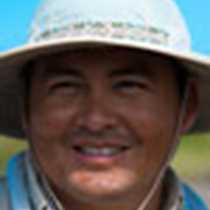Located at the central part of the archipelago, Bartolome looks barren with many extinct parasitic cones as a result of thousands of years of volcanic eruptions. We started our splendid morning outing hiking up the stairs of Bartolome Island very early. It was cloudy with a soft breeze, perfect weather to walk and enjoy a unique volcanic landscape. Loose rocks on reddish volcanic ash surrounded by many sunken volcanic cones made us easy to imagine we were visiting other planet. Along the boardwalk we sighted colorful lava lizards, large painted locusts, and pioneer plants that helped us to have a better understanding of how the islands were populated over time and how close and fragile the food web is in the Galapagos Islands. The great view of Pinnacle Rock made it worth every single breath that it took to get us to the summit of the island.
After breakfast we headed back to Bartolome, but this time to snorkel and swim from the golden beach of the island. We couldn’t wait to get into the water and enjoy a wonderful experience with curious penguins, colorful reef fish, and white-tipped sharks that were found hidden under the rocky shoreline. After snorkeling we all gathered at the beach to talk about our experience in this fairylike place.
In the afternoon National Geographic Islander took us to the Terracotta Island “Rabida.” This place is also known as Jervis Island, named in honor of the 18th century British admiral John Jervis. This bizarre place has a red sand beach and a saltwater lagoon inhabited by waders and bachelor sea lions. The landscape is studded with small volcanic features along sharp slopes and cliffs. The first outing on this island was snorkeling. The rich water here made the underwater realm unforgettable. First, a juvenile Galapagos penguin was found perched on the rocks and later, playful Galapagos sea lions made our afternoon natural quest memorable. White-tipped reef sharks, sea turtles, and the only sea-going lizard in the world (the marine iguana) were spotted by our guests that were delighted with the biodiversity that characterize Rabida Island.
Later in the afternoon our explorers went ashore for a pleasant walk along the beach that was decorated by the tides with sea stars and sea urchins. Sea lions, pelicans, white-cheeked pintails ducks, blued-footed boobies, and several species of finch were sighted while the sun was setting behind the majestic shield volcanoes of Isabela Island. Today our explorers enjoined the magic of the Galapagos in different activities like hiking, snorkeling, and kayaking. Our second day in the last paradise on Earth delivered us a wonderful and unforgettable day.









